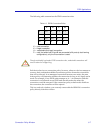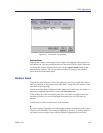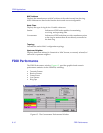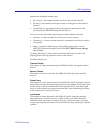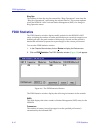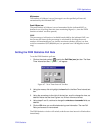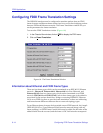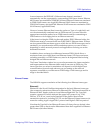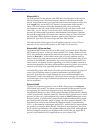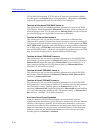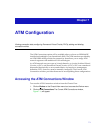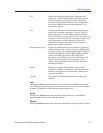
Configuring FDDI Frame Translation Settings 6-15
FDDI Applications
In most instances, the IEEE 802.3/Ethernet frame format is translated
automatically into the appropriately corresponding FDDI frame format. Ethernet
802.2 frames are translated to FDDI 802.2 frames; Ethernet II frames are translated
to FDDI SNAP frames; non-AppleTalk Ethernet SNAP frames are translated to
FDDI SNAP frames; and AppleTalk Ethernet SNAP frames are translated to FDDI
SNAP frames (AppleTalk format).
However, because Ethernet Raw frames do not have a Type or Length Þeld, and
canÕt be automatically translated onto an FDDI network, you must select the
appropriate translation method to an FDDI frame format (for transmitting to
FDDI stations or for bridging back to an Ethernet network).
If the frame is exiting the FDDI ring through another FDDI/Ethernet bridge, the
FDDI frame must be converted back into an IEEE 802.3/Ethernet frame. As there
are four potential Ethernet frame types to which the two FDDI frame types can be
translated, you must determine which translation options you want in effect Ñ
depending on which network protocols and applications are being run on the
destination network.
In addition, there are frame size differences between FDDI (which allows a
maximum frame size of 4500 bytes) and Ethernet frames (1518 byte maximum,
excluding preamble), so FDDI frames may need to be fragmented before being
bridged onto an Ethernet network.
The Frame Translation window lets you set the parameters for frame translation
and fragmentation when Ethernet trafÞc needs to traverse an FDDI ring. The
frame types that you select for translation will depend on which higher-layer
communications protocols and software you are running on the network
segments connected to your Ethernet-to-FDDI bridge. Each frame type and its
usage is described below.
Ethernet Frames
The HSIM-F6 supports translation of the following four Ethernet frame types:
Ethernet II
Ethernet II is the Novell NetWare designation for the basic Ethernet frame type
(also commonly referred to as Ethernet or Ethernet DIX). This frame format has an
Ethernet II MAC header with a two byte Ethernet Type Þeld. The Type Þeld
contains a protocol ID which indicates the upper layer protocol (e.g., XNS,
DECnet, TCP/IP, etc.) used in the Data Þeld of the packet. Most current
transmission protocols, including TCP/IP, use the Ethernet II frame format, as do
networks running AppleÕs AppleTalk 1 protocol and DigitalÕs DECnet protocol.
Note that the Type Þeld of an Ethernet II frame will always have a decimal value
greater than 1500, so that it can be differentiated from the Length Þeld of Ethernet
802.2 frames (described below).



